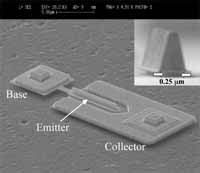Power and Electrical Engineering
This topic covers issues related to energy generation, conversion, transportation and consumption and how the industry is addressing the challenge of energy efficiency in general.
innovations-report provides in-depth and informative reports and articles on subjects ranging from wind energy, fuel cell technology, solar energy, geothermal energy, petroleum, gas, nuclear engineering, alternative energy and energy efficiency to fusion, hydrogen and superconductor technologies.

Energy subsidy is not always favourable
Dutch research has revealed that energy subsidies can delay the dissemination of new energy-saving technologies. Furthermore, companies do not always want to get rid of the old technology straightaway and therefore new ideas are confined to the top shelf for longer.
Ph.D. student Peter Mulder demonstrated that subsidies for investments in energy-saving can have an adverse affect in the longer term. These subsidies can be counter-effective, since they only stimulate investment in existing te

Illinois researchers create world’s fastest transistor — again
Researchers at the University of Illinois at Urbana-Champaign have broken their own record for the world’s fastest transistor. Their latest device, with a frequency of 509 gigahertz, is 57 gigahertz faster than their previous record holder and could find use in applications such as high-speed communications products, consumer electronics and electronic combat systems.
“The steady rise in the speed of bipolar transistors has relied largely on the vertical scaling of the epitaxial layer

Nanowire film brings cheaper, faster electronics a step closer
Researchers at Harvard University have demonstrated for the first time that they can easily apply a film of tiny, high-performance silicon nanowires to glass and plastic, a development that could pave the way for the next generation of cheaper, lighter and more powerful consumer electronics. The development could lead to such futuristic products as disposable computers and optical displays that can be worn in your clothes or contact lenses, they say.
Their research appears in the November is

Bad Mileage: 98 tons of plants per gallon
Study shows vast amounts of ’buried sunshine’ needed to fuel society
A staggering 98 tons of prehistoric, buried plant material – that’s 196,000 pounds – is required to produce each gallon of gasoline we burn in our cars, SUVs, trucks and other vehicles, according to a study conducted at the University of Utah.
“Can you imagine loading 40 acres worth of wheat – stalks, roots and all – into the tank of your car or SUV every 20 miles?” asks ecologist Jeff Dukes,

Workshop Tackles Biological Hydrogen Production
Available report outlines goals, challenges, and research areas
The results of a two-day workshop on hydrogen production through biological and artificial systems now is available.
The workshop, sponsored by the Air Force Office of Scientific Research and hosted jointly by the U.S. Department of Energy’s (DOE) National Renewable Energy Laboratory (NREL) and the Air Force Research Laboratory (AFRL), included key scientists from the Air Force, NREL, DOE, other national la

MIT’s plasmatron cuts diesel bus emissions, promises better gas engine efficiency
A bus in Indiana is the latest laboratory for MIT’s plasmatron reformer, a small device its developers believe could significantly cut the nation’s oil consumption as well as noxious emissions from a variety of vehicles.
The work will be the subject of an invited talk next Thursday, October 30, at a meeting of the American Physical Society’s Division of Plasma Physics in Albuquerque, NM.
The researchers and colleagues from industry report that the plasmatron, used with an exhaust t